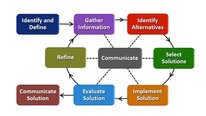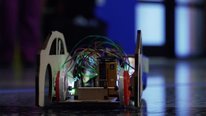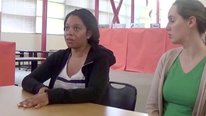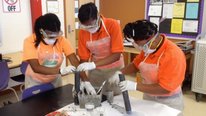
AMANDA SOPKO
The Mathematics of Cryptography and Cyber-Security, A Challenge Based Learnin...
NSF Awards: 1404766
The mathematics unit highlighted in this video was created to build student interest in cryptography through realistic and engaging activities. A series of hands-on activities demonstrate important cryptographic systems and protocols. Students were introduced to protocols and schemes such as Diffie-Hellman in order to understanding present day encryption and decryption. It is important that students understand how these protocols work. As a result, the final challenge in this unit requires students to develop a set of protocols to successfully transmit coins without interception. The strategies used to increase student interest provided them the opportunity to discuss and use present-day cryptographic systems as well as experiment with their own designed protocols making cryptography accessible to middle school students.
The Mathematics of Cryptography and Cyber-Security, A Challenge Based Learnin...
NSF Awards: 1404766
The mathematics unit highlighted in this video was created to build student interest in cryptography through realistic and engaging activities. A series of hands-on activities demonstrate important cryptographic systems and protocols. Students were introduced to protocols and schemes such as Diffie-Hellman in order to understanding present day encryption and decryption. It is important that students understand how these protocols work. As a result, the final challenge in this unit requires students to develop a set of protocols to successfully transmit coins without interception. The strategies used to increase student interest provided them the opportunity to discuss and use present-day cryptographic systems as well as experiment with their own designed protocols making cryptography accessible to middle school students.
-
 Securing Cyberspace: Cryptography in the Classroom
Securing Cyberspace: Cryptography in the Classroom
Benjamin Dougherty
-
 Computer Engineering Design for Middle School Girls
Computer Engineering Design for Middle School Girls
Carolyn Nichol
-
 A cyber-ensemble of learning tools and strategies
A cyber-ensemble of learning tools and strategies
Hiroo Kato
-
 DataSketch: Data-Driven Visualization in Middle School
DataSketch: Data-Driven Visualization in Middle School
Michelle Wilkerson
-
 Cincinnati Engineering Enhanced Math and Science Program
Cincinnati Engineering Enhanced Math and Science Program
Julie Steimle
-
 EngrTEAMS Targeted Mathematics-Science Partnership
EngrTEAMS Targeted Mathematics-Science Partnership
Tamara Moore
8771 Views
Continue the discussion of this presentation on the Multiplex. Go to Multiplex
8771 Views
Related videos you might be interested in...
-
 Securing Cyberspace: Cryptography in the Classroom
Securing Cyberspace: Cryptography in the Classroom
Benjamin Dougherty
-
 Computer Engineering Design for Middle School Girls
Computer Engineering Design for Middle School Girls
Carolyn Nichol
-
 A cyber-ensemble of learning tools and strategies
A cyber-ensemble of learning tools and strategies
Hiroo Kato
-
 DataSketch: Data-Driven Visualization in Middle School
DataSketch: Data-Driven Visualization in Middle School
Michelle Wilkerson
-
 Cincinnati Engineering Enhanced Math and Science Program
Cincinnati Engineering Enhanced Math and Science Program
Julie Steimle
-
 EngrTEAMS Targeted Mathematics-Science Partnership
EngrTEAMS Targeted Mathematics-Science Partnership
Tamara Moore
Jennifer Knudsen
this is great! Is it possible to see the student blogs?
Pati Ruiz
Dean of Studies
Secrets seem like a great hook for students to learn about cryptography. Secretly passing messages and learning about cryptography through a game (final challenge) seems like a great approach!
What does the end of this lesson look like? Is there a competition or a showcase with other students or adults in the community? Is there a metacognitive piece at the end – in addition to the ones you discuss in the video? There is a lot of learning going on, how are you capturing it – is this all done on the blog and in their notebooks?
Jenna Marks
Doctoral Student in Cognitive Studies in Education
This answers the question I posed in another video your team (or a related team at Cincinnati) posted about high school cryptography (http://stemforall2016.videohall.com/presentatio...), which was how could this be scaled to middle school. I think you’ve done an excellent job of taking a complex topic and making it palpable to such a young audience.
Have you done any quantitative or qualitative analysis of student motivation during and after these tasks? For example, I would be interested to see how this unit affects engagement in the math classroom.
Avron Barr
Consultant
Interesting project. Great video. Thanks Amanda. You introduced a lot of concepts, besides cryptography. How long was this unit? How many students? Any plans to continue this work?
Kevin Adams
Hello,
What a wonderfully interesting project! I was wondering if you had any specific videos that you use with the students that gives them a historical perspective and a modern day perspective.
Andrew Izsak
Hi Amanda,
What an interesting project. I was wondering what main math ideas were developed in the project. There was mention of modular arithmetic. Bar codes are another interesting application of modular arithmetic.
Andrew
Further posting is closed as the showcase has ended.